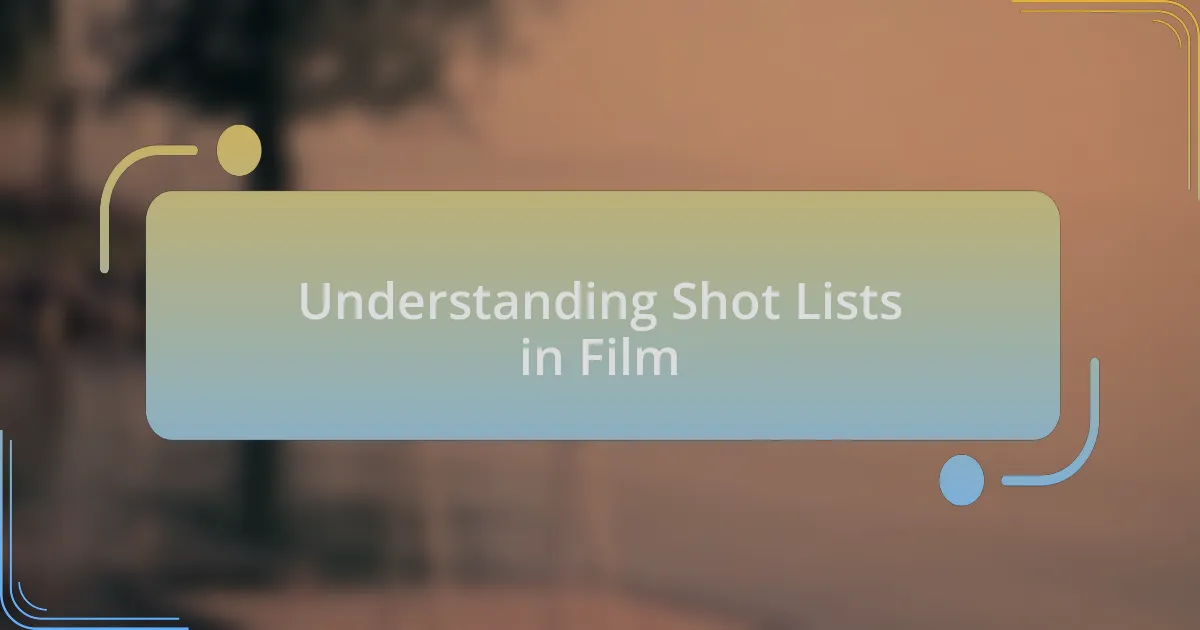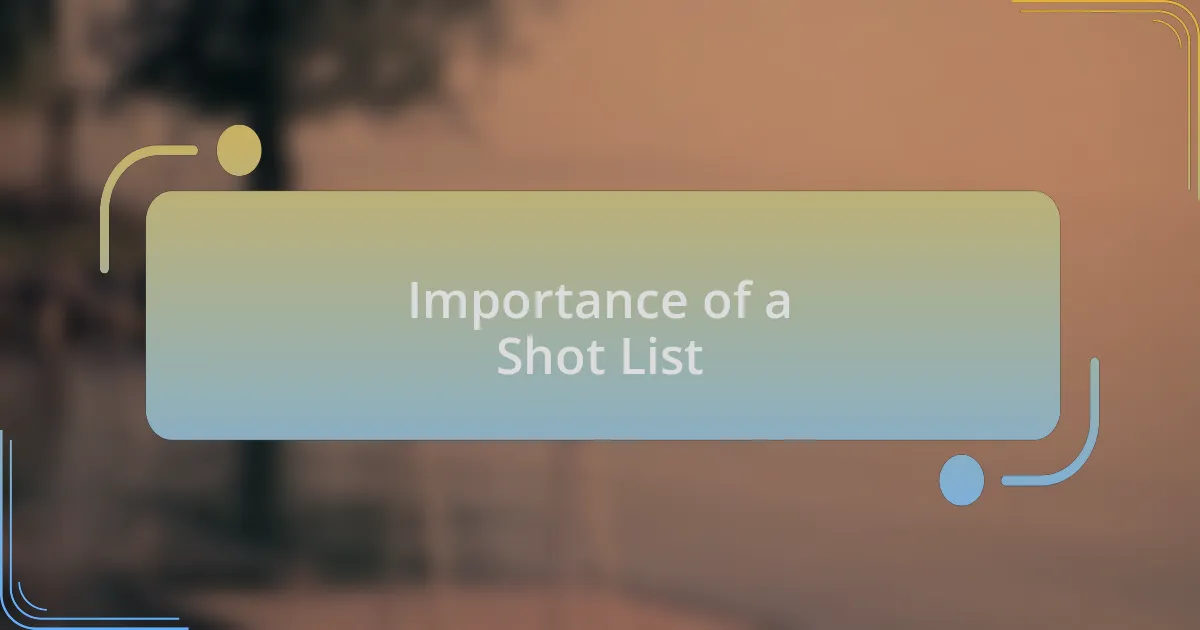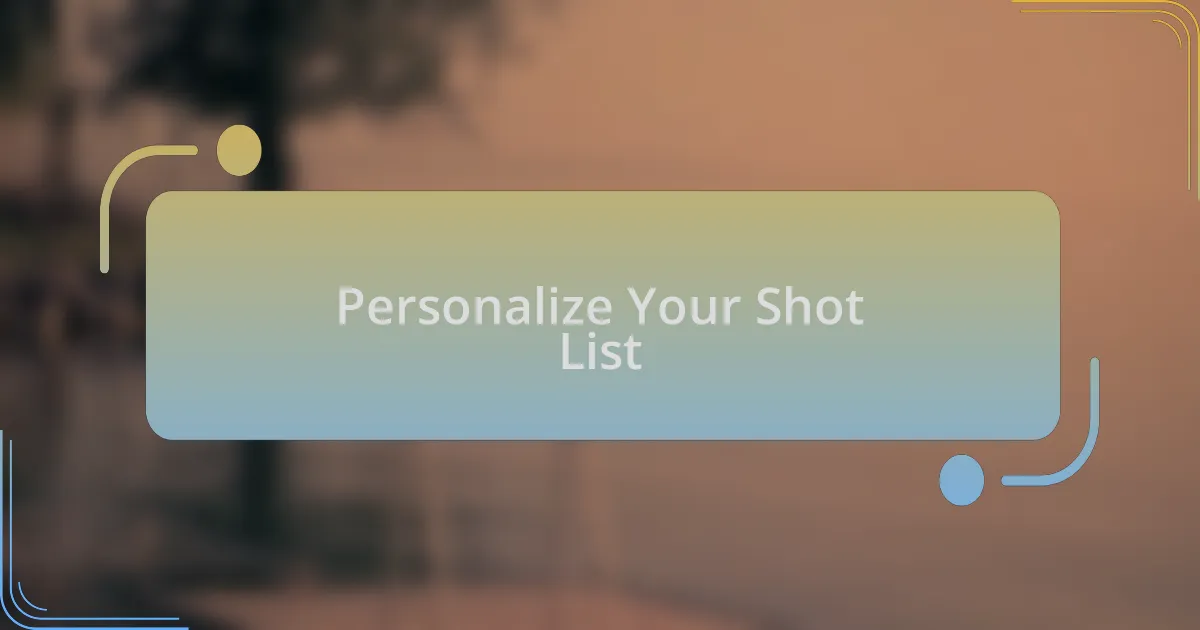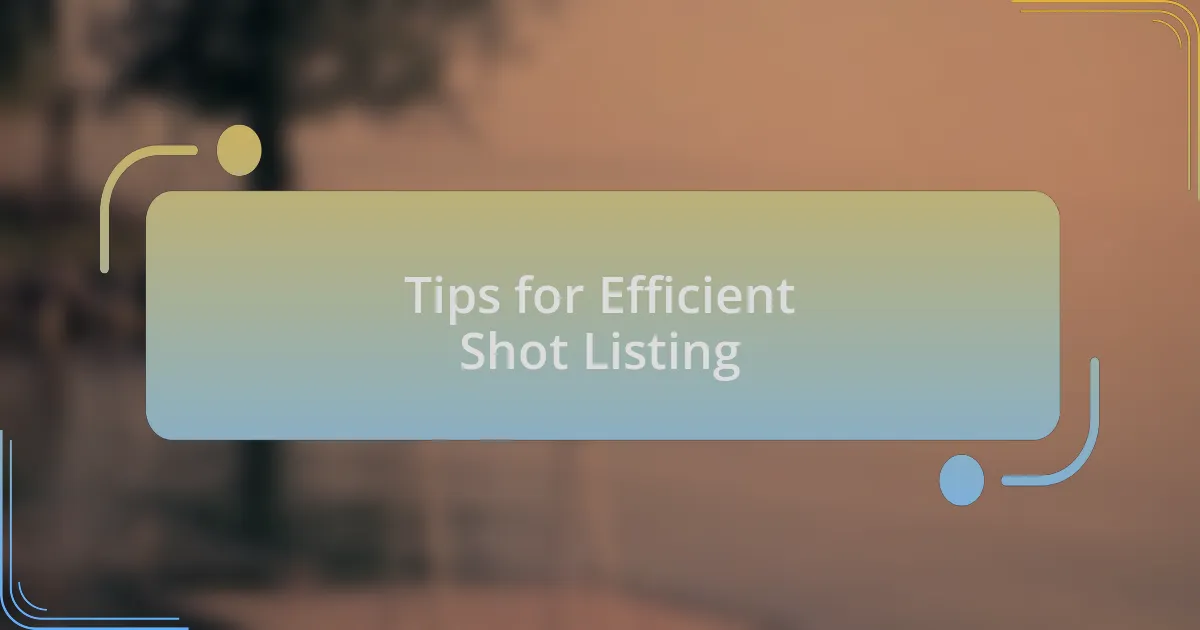Key takeaways:
- A shot list acts as a vital roadmap during film production, enhancing organization and communication among the crew.
- It allows for creativity and adaptability, enabling filmmakers to capture compelling shots while staying aligned with the overall vision.
- Personalizing the shot list according to emotional beats and specific circumstances enriches storytelling and fosters deeper audience connection.
- Effective shot listing involves categorization, prioritizing crucial shots, and collaborating with the team to incorporate diverse perspectives.

Understanding Shot Lists in Film
A shot list serves as a roadmap for a film production, detailing every planned shot for a scene. From my own experience on set, that list can feel like a lifeline. When I glance at it, especially during chaotic shooting days, it centers me, ensuring I capture every essential moment while keeping the team aligned.
What often struck me during my projects is how a well-structured shot list enhances communication among the crew. It’s not just a list of angles and positions; it’s a shared vision of the story we’re telling. Have you ever found yourself lost in the frenzy of filming? I have, and I can say that revisiting the shot list instantly refocuses my energy and helps prioritize what’s vital.
Moreover, I’ve learned that adjusting a shot list is part of the creative process. It evolves as ideas develop on set—there’s something exhilarating about making those last-minute adjustments that can breathe new life into a scene. Reflecting on those moments, I realize that each change signifies not just a shift in logistics but a deeper engagement with the unfolding narrative.

Importance of a Shot List
A shot list is crucial for staying organized and efficient during production. I remember a time when we had a limited shooting window, and having that shot list allowed us to maximize every minute. It felt like having a game plan in a high-stakes match; we knew exactly what needed to be done, and that clarity made all the difference.
Another aspect I’ve found invaluable is how a shot list facilitates creativity on set. There have been instances where, while shooting a specific angle, I unexpectedly discovered a more compelling composition. Instead of deviating from our plan entirely, the shot list provided a foundation that allowed us to explore creatively without losing sight of our main objectives. Have you ever felt the thrill of a spontaneous idea blending seamlessly with a solid plan? It’s one of the best feelings in filmmaking.
Lastly, I can’t overstate the importance of a shot list for post-production. When I sit down to edit, that list is my guiding star, reminding me of the intentions behind each scene. It helps me understand how each shot contributes to the overall narrative flow. I find myself asking, “Did we capture the emotion we aimed for?” and my shot list answers back, ensuring that each piece of footage aligns with our vision. This is what makes it essential for both the shooting and editing phases.

Personalize Your Shot List
When personalizing my shot list, I always consider the story’s emotional beats. There was a project where the main character faced a critical turning point. I decided to mix close-ups of their expressions with wider shots of the surrounding environment. This decision was driven by a desire to evoke the audience’s connection to the character’s inner turmoil, and it made the final edit feel more immersive. Have you ever noticed how a well-constructed shot can pull you into a narrative? That’s the beauty of tailoring your shot list to the emotional stakes.
Another aspect of personalization is adapting the shot list to the unique dynamics of my crew and location. I once worked with a small team in a cramped space, and instead of sticking rigidly to traditional setups, we embraced handheld shots to capture the raw energy of the environment. This flexibility turned into a defining feature of the film’s aesthetic. By being attuned to the specific circumstances, I’ve learned that a good shot list isn’t just a checklist; it’s a living document that evolves as the production unfolds.
I also find that detailing my shot list for specific themes enhances the creative process. In one film, I focused on the theme of isolation, so I included shots that emphasized negative space around my characters. It was a conscious effort to visually reflect their emotional solitude. This approach taught me that each entry on my list has the potential to communicate deeper layers of meaning. When crafting your shot list, ask yourself: How can I use different angles, distances, and framing to enrich the story? The answers can transform your film from good to unforgettable.

Tips for Efficient Shot Listing
When developing a shot list, I find that categorizing shots by type can streamline the process significantly. For instance, I often create sections for establishing shots, close-ups, and action sequences. This method not only keeps things organized but also helps me visualize the flow of scenes. Have you ever had a moment where a disorganized list led to chaos on set? Trust me, clarity is key.
Another effective approach is to prioritize your shots based on their importance to the narrative. I remember working on a project where a crucial scene hinged on a single shot – a tight close-up of a character’s face during a significant revelation. By designating it as a priority early on, I could allocate the necessary time and resources to get it just right. How often do we let less critical shots take our attention away from pivotal moments? It’s a trap I’ve fallen into, and it taught me to focus on what truly matters.
Lastly, collaborating with team members while drafting the shot list can bring a wealth of perspectives that enrich the final product. During a recent short film, the cinematographer suggested we integrate creative transitions that I hadn’t initially considered. This brainstorming led to a sequence that flowed in a way that strengthened the storytelling. So, don’t hesitate to invite your crew into the shot-listing process – their insights might open doors you hadn’t even thought to knock on.